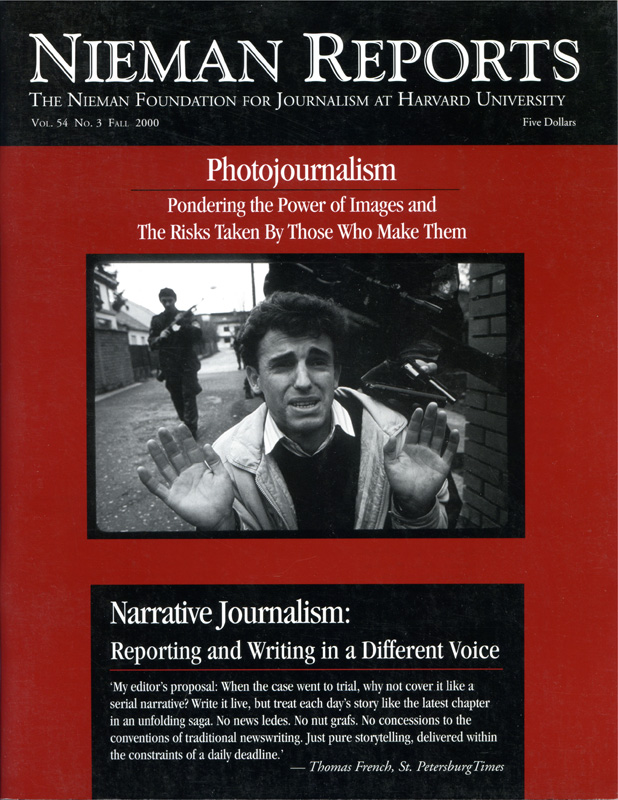I tell stories on television. I tell them long (on “Nightline” and “Frontline”), I tell them medium (on “Prime Time Live”), and I tell them short (on the evening news), and like any storyteller, I want my audience’s complete attention while I am on the screen. But what I really want is a couple of hours after I’ve finished, I want some of them, half would be nice, to remember what I’ve said; not all of it, just the gist, and if not the gist, maybe an image, a thought, something sticky enough to carry my message a couple of beats past my performance.
Everybody knows TV news is ephemeral. But the sad truth is news on network TV has become so smooth, so polished, the typical story moves through the audience like a suppository. In. Out. “What did he say?”
I will be standing on a street corner, waiting for the light to turn, and somebody with a big smile will come up to me and say, “I saw that thing you did on TV yesterday about the—”
I wait. I tense.
“About the—”
About half the time what the person recalls, I never said, or some other reporter said, or it was sort of what I said but skewed in some unfathomable way, or whatever memory sparked this exchange flickers, dims, and ends: “That thing, you know, you said yesterday, it was—” (long pause).
“Well, thanks,” I say, unhelpfully.
On the radio (I used to work for National Public Radio), this is not a problem. Radio reporters learn to write with calculated vividness, pushing the listeners to paint images in their own heads so they unwittingly become coauthors of the story. On the radio, a story well told sticks for days, years.
TV is harder. Good television reporters have to learn how to work the room. On television, the audience is two, five, seven, 15 feet away staring back across a couch, a bed, a kitchen table. This distance matters. Consider: A newspaper reporter puts words on a page and that page is usually 18 inches from the reader’s nose. How many children, spouses and pets can squeeze into those 18 inches? Between the TV and the viewer there can (and will) be a Barnum & Bailey carnival of “Watch me instead!” distractions.
Every good television reporter knows the real job is to grab the audience’s eyes and hold them tight through the storm.
How do I do that? I begin with an observation: TV news has a very familiar form. It is authoritative, cadenced, smooth, dispassionate, articulate. It doesn’t gulp or waffle or giggle. It is a speech pattern that carefully announces that it is not normal conversation; it is News. News on TV has a sound, a sound designed to create credibility. I talk this way, it says, because what I am saying is True and Important. Now listen.
The problem is that sound has become so familiar that at some level that composers would understand, it has become very easy not to listen. We know these tones, this writing style, these image sequences so well, we don’t have to pay attention. We know the beat.
The opportunity here is obvious. If most reporters are modeling themselves on Walter Cronkite and Jane Pauley, what I do is model myself on no one. Instead, implacably, incorrigibly, I try to sound like myself, like the ordinary me.
If I were sitting next to you on a bus and we got to talking about something that I know about, something exciting (to me) like a tax proposal, a scientific discovery, something difficult, but something I’d want to explain, on television I try to sound exactly as I would on the bus. True, on TV I have the advantage of pictures and graphics and snippets of interviews, but I work hard to create a sequence that feels as improvised, fresh and intimate as an accidental encounter.
This means: a) whenever I sound too much like Pauley or Cronkite (who are good, by the way, icons, even), I consciously shift down, to take the “News” out of my voice, and b) I cut and arrange my images so that they do not flow normally. I want surprise. I want to create a pattern that is instinctively unfamiliar, so that at a level the audience may not be aware of, there is a touch of suspense. What’s he going to do, say, now?
Sometimes this works. A few months ago, I was on the A train in New York City, my home town, three o’clock in the afternoon, when the guy across from me, in full hip hop garb, the gold chain, three earrings on the right lobe, big pants, leans over and he says, “Hey, didn’t I see you on TV talking about the—”
“Yes?”
And he delivers a perfect condensation of a story I did on Dolly the cloned sheep’s cells. He remembered the whole thing. It is moments like these that make me want to dance off the train, bow deeper than I ever would for an Emmy, and touch the hem of Stephen Jay Gould. It doesn’t happen often, maybe three out of every 10 encounters, but on TV (as in baseball) .333 is a pretty good average. Way good enough for me.
Robert Krulwich is a correspondent with ABC News.


